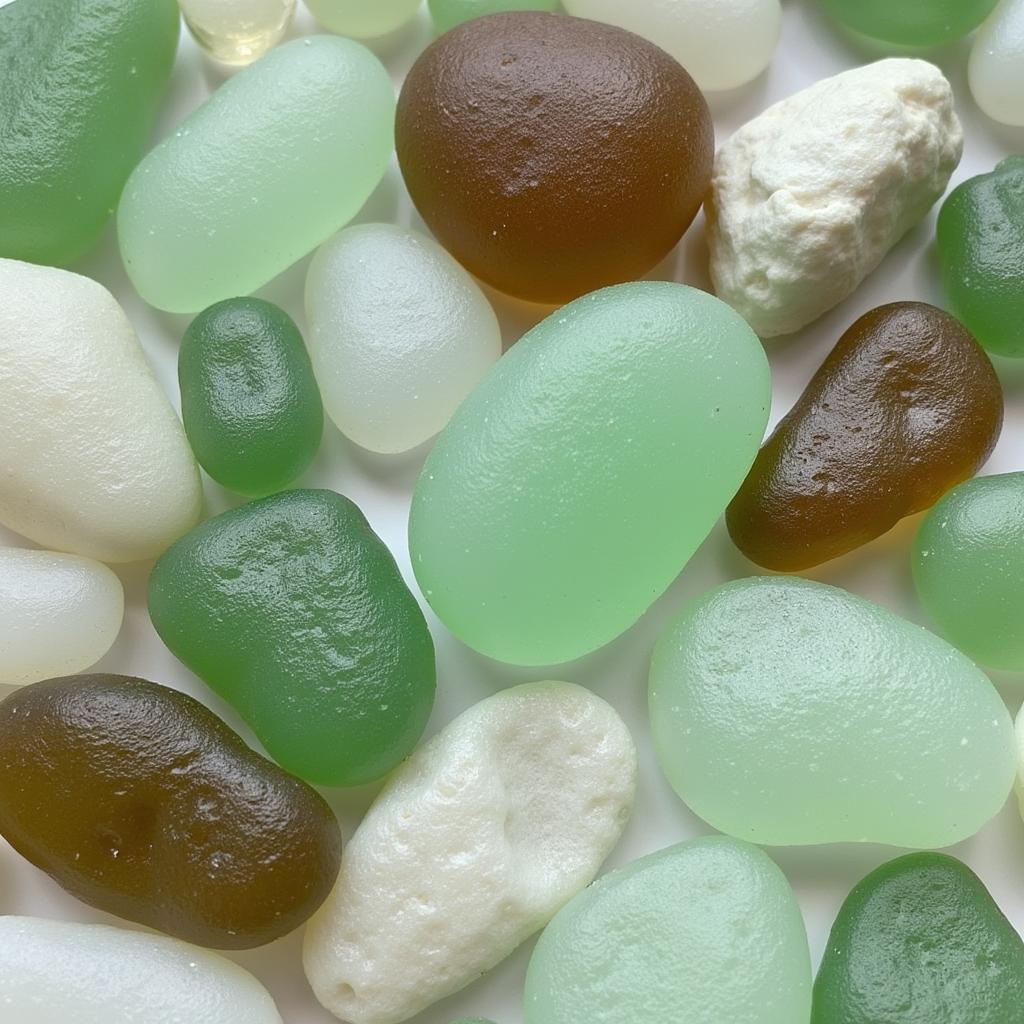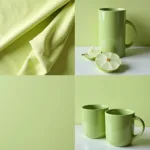Sea glass, those frosted jewels found scattered along shorelines, captivates with its unique beauty and the mystery of its origins. But what color is sea glass, really? The answer isn’t as simple as you might think. From the common greens and browns to the rarer blues and reds, sea glass comes in a surprising array of hues, each telling a silent story of its journey through the ocean’s depths.
Unraveling the Hues of Sea Glass: A Spectrum of Colors
Sea glass starts as ordinary glass – bottles, jars, tableware, even windows – that finds its way into the ocean. Over time, the relentless action of waves, sand, and salt transforms these discarded shards into the smooth, frosted treasures we admire. The color of sea glass is primarily determined by the original color of the glass, with certain colors being more prevalent than others.
The most common sea glass colors are green, brown, and white. These hues originate from beer bottles, soda bottles, and clear glass, respectively. The prevalence of these colors reflects the high volume of these types of glass items that were historically discarded. However, rarer colors like blue, aqua, and seafoam green, often originating from vintage medicine bottles, inkwells, and other less common glass items, are highly sought after by collectors. Even rarer still are shades of red, orange, yellow, and purple, each carrying a unique history and commanding a premium price.
 Common Sea Glass Colors: Green, Brown, and White
Common Sea Glass Colors: Green, Brown, and White
What Factors Influence Sea Glass Color?
While the original color of the glass is the primary factor, other elements contribute to the final hue of sea glass. The chemical composition of the glass itself plays a role. For instance, manganese dioxide, added to glass to remove greenish tints, can react with UV rays over time, creating a lavender or amethyst hue. Similarly, selenium, used to create pink or salmon-colored glass, can deepen to a rich red after years at sea. The length of time the glass spends in the ocean also affects its color. Longer exposure typically results in a more frosted appearance and sometimes a slight shift in hue. The specific location and the minerals present in the water can also influence the final color, adding another layer of complexity to the story of each piece.
Identifying Rare Sea Glass Colors: A Collector’s Guide
Identifying rare sea glass colors can be a thrilling pursuit. what is the rarest color of sea glass offers a deeper dive into this fascinating topic. Red, orange, and yellow are among the rarest sea glass colors, often originating from old ship lanterns, traffic lights, and other specialized glass items. Black sea glass, while seemingly common, can actually be quite rare, with genuine black sea glass originating from 18th-century bottles. Learning to distinguish between genuine sea glass and artificially tumbled glass is essential for collectors. Genuine sea glass exhibits a unique surface texture and subtle variations in color that are difficult to replicate.
Why is some sea glass green?
The abundance of green sea glass comes from the widespread use of green glass for beer and soda bottles throughout history.
How can I tell if my sea glass is real?
Authentic sea glass has a frosted texture and often exhibits subtle variations in color.
what color is seaglass explains this further.
The Allure of Sea Glass: More Than Just Pretty Colors
Beyond its aesthetic appeal, sea glass represents a connection to history and the power of nature. Each piece is a testament to the enduring qualities of glass and the transformative forces of the ocean. is food coloring a chemical change touches on the fascinating interplay of chemicals and color, a theme echoed in the formation of sea glass. Whether you’re a seasoned collector or simply appreciate the beauty of these ocean-tumbled gems, understanding the complexities of sea glass color adds a deeper layer of appreciation for this natural wonder.
“The beauty of sea glass lies not just in its color, but in the story it whispers of its journey through time and tide,” says Amelia Stone, a renowned sea glass expert.
“Each piece is a unique work of art, sculpted by the ocean’s embrace,” adds Dr. James Carter, a marine geologist.
what color shirt to wear with khaki shorts offers insights into color coordination, a principle that can also be applied to appreciating the diverse palette of sea glass.
In conclusion, the question “what color is sea glass?” opens a door to a fascinating world of color variations, historical influences, and natural processes. From the common greens and browns to the rare reds and oranges, each piece of sea glass holds a unique story waiting to be discovered. when is the eclipse in colorado springs highlights the power of natural phenomena, much like the creation of sea glass itself. The allure of sea glass lies in its ability to connect us to the ocean’s mysteries and the passage of time.
FAQ:
- What is the most common color of sea glass? (Green)
- What is the rarest color of sea glass? (Red, orange, yellow)
- How is sea glass formed? (By the tumbling and erosion of glass in the ocean)
- How can I identify real sea glass? (Look for a frosted texture and subtle color variations)
- Where can I find sea glass? (Along beaches and shorelines)
- How long does it take for sea glass to form? (Decades, even centuries)
- What are the different types of sea glass? (Various colors and types of original glass)
Need help with your color journey? Contact us at Phone: 0373298888, Email: [email protected] or visit us at 86 Cau Giay, Hanoi. We have a 24/7 customer service team.

